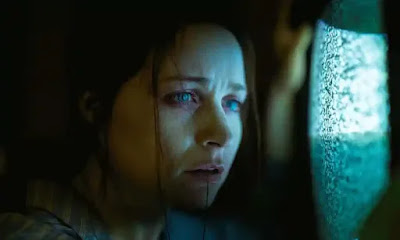If any of this reminds you of the plot of Dracula, it should. Early drafts of the screenplay were intended to be a direct adaptation of Bram Stoker's hit novel. While Dracula had long been adapted for the stage it hadn't yet been made as a film ... that had any market penetration (Google is your friend). There might have been a reason for that for, as soon as she found out that some Germans were trying to do just that Stoker's widow called out: That's mine. Well, it's Bram's but he said I could have it. So they made it with names and settings changed and it became Nosferatu which is Romanian (ish) for vampire/undead/fiend that broke the bank at Monte Carlo. Why Romanian? That's where Transylvania is, for real.
So, now that it's a hundred years old, is it any good? If you ask the woman at the screening Nova gave free for anyone who paid to see Shadow of a Vampire that night, it's laugh a minute. If you ask the guy who said, loudly, to her, "take your bloody Prozac, please," to massive applause, then he'll probably differ. If you're like the lady you probably need to be informed that the Earth was formed a fair while before your birth and many things took time to get to the state they are in today and maybe question what you actually get out of fiction. If you're like the lad, you might well find this among the most rewarding experiences you are likely to have of early cinema.
F.W. Murnau's film of Nosferatu is a triumph of invention, using the scant means available he and his gang created a film that is durably effective and will dazzle any mind that can appreciate the difficulties of conceiving of its physical effects (let alone getting them done). This was not the first horror film by many years but it was made when genre films were yet to find the traits that gave them that identity. The scene in which Ellen in Germany is so bonded with Thomas in Transylvania that she projects enough of her will to protect him from the Count who is poised to attack. It disturbs the overall logic but adds a real eeriness that suggests that this telling of the tale will go where it needs to.
Max Schreck (schreck means fright in German) gives as an otherworldly figure in the Count, his elongated face and bulging stare are almost more powerful an indication of his animalistic state than his stretched fingers and their claws. His movement is variously rat nimble and primate clumsy when not purely unnatural (due to early stop motion, and under cranking). He can vanish into the light of a room or appear to bleed from the shadows. He can be a shadow, climbing the silent stairs against the wall and reaching for the door of his victim. He is beyond our reason's control which is why, even now, when a still might bid us chortle at the extremity of his appearance, he can still command the screen as soon as you see him move.
Nosferatu lives in a world in which the genre it helped create rolls through many revolutions, going from the meagre to the lavish and, in revolt, back to the meagre when it needs to refresh. But Nosferatu is a constant. Having all the invention of a studio-indulged mega movie but all the subversion of a game-changer made in a cellar. Looking at it now feels like watching something not just from the dawn of cinema but the dawn of time: it's hard antiquity gives us the sense of peering through time at the impossibly recorded past. I don't mean that it's old or even that it's timeless despite that; I mean that it can be viewed in disregard for either of those things. It's laggy here and too fleeting there, the performances are uneven and its technological hurdle (by being silent) can daunt most of us but, once we're there in front of it, being filled by its images we are where the best of cinema takes us: somewhere else. Imagine, if you sit before it, that you are seeing it fresh, a century ago, this freakish thing that grips you in the dark and might never end. The world outside the cinema will be forever changed when you step back into it. Imagine all movies had that charm. Recall that they don't. That's why Nosferatu is still crazy.





